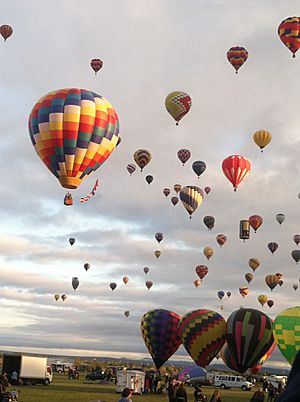Balloon Federation of America facts for kids
The Balloon Federation of America (BFA) is a non-profit club for people who love flying in hot air and gas balloons. Think of it as the main group in the United States for everything related to ballooning. It was started in 1960 and is based in Indianola, Iowa.
The BFA works with the National Balloon Museum to honor amazing people in the United States Ballooning Hall of Fame. The BFA also gives out special awards to skilled pilots and helpful crew members. A big part of their job is to help balloon events run smoothly and safely, following the rules set by the government.
Anyone can join the BFA. Members get a magazine called "Ballooning," and they can earn awards for their flying skills. The BFA also has a video library to help teach pilots and crew members, and it offers online classes about safety. Members can also join youth programs, compete in balloon races, or even get help with legal questions related to ballooning.
Contents
The Story of the BFA
The first national balloon club in the U.S. was the Balloon Club of America (BCA), started in 1948 by a balloonist named Don Piccard. He worked with another early member, Tony Fairbanks. After World War II, the U.S. Army had extra balloons, and these were given to balloon clubs across the country for free. This helped more people get into the sport.
Then, in 1960, a group of employees from General Mills, including a man named Ed Yost, invented the modern hot air balloon we see today. This was a huge deal! With this new type of balloon, Ed Yost and other balloon fans went to Washington D.C. to get official government recognition for their sport.
With help from the National Aeronautic Association (the group in charge of air sports in the U.S.), they created a new organization: The Balloon Federation of America. Ed Yost, who is often called the "Father of Modern Hot Air Ballooning," told the first members to treat balloons as something precious and to make their new organization just as special.
The National Balloon Museum
The National Balloon Museum is a special museum in Indianola, Iowa, all about the history of hot air and gas ballooning. It opened in a permanent building in 1988. The museum building is even shaped like the basket of a hot air balloon!
Another major balloon museum in the U.S. is the Anderson-Abruzzo Albuquerque International Balloon Museum in Albuquerque, New Mexico.
What's Inside the Museum?
Indianola began hosting the U.S. National Hot Air Balloon Championship in 1970. The event was so popular that people started creating exhibits about ballooning each year. Soon, they realized they needed a permanent place to show off these cool items, and the idea for the museum was born.
The museum's collection tells over 200 years of ballooning history. It even has the very first hot air balloon that successfully flew across the English Channel. Inside, you can also find the U.S. Ballooning Hall of Fame, a library, and a fun area for kids where they can learn more about balloons.
The museum is run entirely by volunteers. Every year, in late July, it hosts a big festival called the National Balloon Classic, which draws huge crowds.
U.S. Ballooning Hall of Fame
Located inside the National Balloon Museum, the U.S. Ballooning Hall of Fame honors people who have made important contributions to the sport of ballooning.
Instead of a long list of names, here are a few famous people who have been honored:
- Ed Yost: The inventor of the modern hot air balloon.
- Malcolm Forbes: A famous publisher who loved ballooning and flew many unique balloons.
- Joseph Kittinger, Jr.: A U.S. Air Force pilot who set a record for the highest skydive from a balloon in 1960.
- Steve Fossett: An adventurer who was the first person to fly a balloon solo around the world.
- Don Piccard: A pioneer who helped start the first national balloon club.
Rules for Flying Balloons
Just like cars on a road, hot air balloons have to follow rules to keep everyone safe. In the United States, the FAA (Federal Aviation Administration) makes these rules.
Rules for Balloons
Every hot air balloon must be registered and have a special number, called an "N-number," just like an airplane. It also needs a certificate to prove it's safe to fly and must be inspected every year. Very small and light balloons can sometimes be flown as ultralight aircraft, which have slightly different rules.
Rules for Pilots
To fly a balloon, a person needs to earn a pilot certificate from the FAA. This means they have to go through training and pass tests to show they know how to fly safely. When the modern hot air balloon was first invented in the 1960s, there were no specific rules for it. The FAA created the first official rules and license requirements for balloon pilots around 1974.
See also



